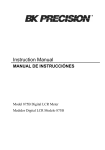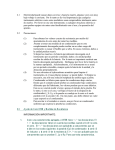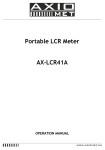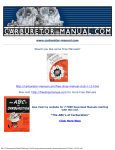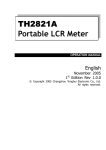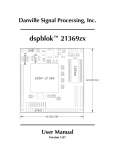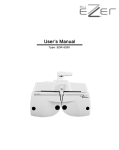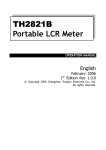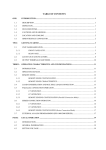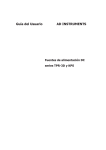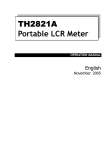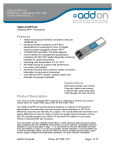Download MIC-4070D User Manual
Transcript
Model : MIC-4070D DIGITAL LCR METER OPERATION MANUAL Inductance Measurement 0.1H to 200H Capacitance Measurement 0.1pF to 20000F Resistance Measurement 1mto 20M Dissipation Factor Mesaurement TABLE OF CONTENTS ONE: TWO: INTRODUCTION 1.1 Inspection 1.2 Included Items 1.3 Unit Descriptions OPTERATION AND MEASUREMENT 2.1 Warning 2.2 Cautions 2.3 875B Zero Adjustment and Impedance Measurement 2.3.1 Zero Adjustment and Capacitance Measurement 2.3.2 Zero Adjustment and Inductance Measurement 2.3.3 Resistance Measurement 2.4 Measurement Parameter Conversions THREE: SPECIFICATIONS FOUR: 3.1 Power Source 3.2 Instrument Specifications 3.3 General Specifications USEER MAINTENANCE 4.1 Battery Replacement 4.2 In Case of Difficulties FIVE: SERVICE INFORMATION 2 ONE: INTRODUCTION Congratulations! You have just purchased some of the most advanced hand-held digital LCR meter available. This meter is sure to provide years of reliable service. The MIC4070D is designed to measure the parameters of an impedance element with high accuracy and speed. Measurements of inductance, capacitance, resistance (equivalent series resistance) and dissipation factor are provided for over a broad band of ranges. In addition, you’ll find that it is ideal for testing SMD type components. Plus, the instrument offers advanced features, such as the ability to perform precision measurements of very low resistances with the 2 ohm and 20ohm ranges, and ideal for high inductances with the 20H and 200H ranges, along with the unique drop-proof construction, combine to make the unit the most versatile handheld LCR meter available today. With proper care and use, these meters can provide years of reliable operation. Therefore, it is very important to completely familiarize yourself with the instrument before attempted use. Please read this manual carefully, paying particular attention to the safety section. 1.1 Inspection When you unpack your new Meter from its original packaging, carefully check each item for damage that may have occurred in shipment. If anything is damaged or missing, take the entire instrument, including the box and packing materials, back to the distributor from whom it was purchased, where they will either replace the missing or damaged item or the entire instrument. 1.2 Included Items Meter Test Leads (1 pair) 1 Battery SMD type component test probes. 1.3 TL-06. (optional) Unit Description Please use the drawings of the MIC4070D, in conjunction with the following descriptions of the controls and connections to help familiarize you with the unit: (1) Liquid Crystal Display : Indicates the value of capacitance connected to the test inputs. (2) LCR/D Mode Switch : Selects either LCR or Dissipation Factor measurement mode. (3) Function/Range Switch : Selects the function and range for the desired measurement. (4) Common Terminal Slot : The negative (common) test connector for all measurements. (5) Positive Terminal Slot : The positive (high) test connector for all measurements. (6) Common Terminal Jack : The negative (low) banana jack for measurements requiring the use of test leads. (7) Positive Terminal Jack : The positive (high) banana jack for measurements requiring the use of test leads. (8) Battery Compartment : Access for the battery. (9) Tilt Stand : Used to hold the instrument at an angle on a level surface, or when reversed to hang it from a projection. (10) Zero Adjust : Control used to zero the display. (11) Power Switch : Turns power to the instrument on and off. 2 TWO: OPERATION AND MEASUREMENT 2.1 Warning Electricity can cause severe injuries or even death, sometimes even with relatively low voltages or currents. Therefore it is vitally important that any electronic instruments such as these meters be totally understood before use. Please do not use this instrument, or any other piece of electrical or electronic test equipment, without first thoroughly familiarizing yourself with its correct operation and use. 2.2 Cautions (1) To obtain accurate impedance values, perform zero adjustment before measurements. (2) Attempted measurement of charged capacitors will overload the instrument. (3) If a dead or partially discharged battery is left in the instrument for an extended period, damage to the unit could result from battery leakage. Therefore it is important to replace a discharged battery promptly. Please dispose of the used battery in a proper manner. Additionally, if the instrument will not be used for an extended period, always remove the battery from the unit and store it separately. (4) Do not use solvents or aromatic hydrocarbons to clean the instrument, or the plastic case may be damaged. If cleaning is necessary, use only a mild solution of warm water and soap. (5) Capacitors are manufactured to operate under certain conditions. Since the meter may test a capacitor under different conditions than of the manufacturer, the values 3 might not be identical. This is not due to meter error, just the method of test. Therefore, if this is the case, check the capacitor’s dissipation factor (0.1) and whether the test was conducted in series or parallel mode (ref. Section 3.6). Use the equations to convert between the modes. At this point, one should obtain a value to that stated on the capacitor. (6) To ascertain if the meter is accurate, please use a standard capacitor that states test conditions. 2.3 MIC4070D Zero Adjustments and Impedance Measurements IMPORTANT INFORMATION: 1. As an added feature, the MIC4070D has +/- offsets. The +/-offsets allow for measurements when the LCD is not at zero. The +/- offsets are applicable to components that are measured in the following modes: capacitor parallel (Cp), inductor series (Ls) and resistance series (Rs). The +/- offsets are not applicable for components that are tested Cs, Lp or Rp. To use this feature, just simply add/subtract the value from the measured value of a component. 2. For impedance measurements there are two different test modes: parallel and series. These distinct test modes obtain different results. Refer to section 2.4 for conversions. 2.3.1 Zero Adjustment and Capacitance Measurement (1) Set the power switch to the “on” position. (2) Set the mode switch to the “LCR” position. (3) Set the Function/Range switch to the appropriate capacitance range for the capacitor under test. If the capacitance value is unknown, select the 200pF range. NOTE: If test leads will be used in the measurement, have them plugged in the banana jacks, but not connected. 4 200pF, 2nF, 20nF, 200nF & 2µF Range (Cp): Zero Adjustment (Cp Mode) (4) Set the Capacitance meter to the selected Capacitance range. (5) Using a small, flat-blade screwdriver, slowly turn the “0 Adj” control to calibrate the display for a zero reading. Now the meter is calibrated for these four ranges. (6) Set the meter to proper capacitance range and go to step seven to measure capacitance. 20µF, 200µF, 2mF & 20mF (Cs): Range Zero Adjustment (Cs Mode) (4) Set the capacitance meter to the 2µF Capacitance range. (5) Using a small, flat-blade screwdriver, slowly turn the “0 Adj” control to calibrate the display for a zero reading. Now the meter is calibrated for these four ranges. (6) Set the meter to proper capacitance range and go to step seven to measure capacitance. Capacitance & Dissipation Factor Measurements (7) Discharge the capacitor to be measured. (8) Insert the capacitor leads into the component test sockets at the front of the meter. If the capacitor leads are too short, use the alligator clip leads provided with the instrument to connect to the capacitor. Be sure to observe the proper polarity if the capacitor is a polarized type. (9) Read the capacitance value in the display. If “1---“(a one with the following 3 digits blanked) is shown (which indicates an over-range reading), move the range switch to the next higher capacitance. If necessary, perform zero adjustment before measurement. (10) To measure the “Dissipation Factor” of the capacitor, set the 5 mode switch to the “D” position, and read the dissipation factor value in the display. (11) ESR Fur capacitors “Equivalent Series Resistance” is typically much larger than the actual “ohmic” series resistance of the wire leads and foils that are physically in series with the heart of a capacitor, because ESR includes also the effect of dielectric loss. SR is related to D by the formula ESR=Rs=D/wCs (where w represents “omega” =2 pi times frequency). In 20mf range, the dissipation factor can be obtained by the formulary D= WCsRs where Cs in the measured value and Rs is measured by 2 range. NOTE: To avoid possible damage to the instrument, discharge all capacitors before attempting to measure the value or dissipation factor. 2.3.2 Zero Adjustment and Inductance Measurements 200µH, 2mH, 20mH, 200mH range (Ls): Zero Adjustment & Measurements (1) Set the power switch to the “on” position. (2) Set the mode switch to the “LCR” position. (3) Set the Function/Range switch to the appropriate range for the inductor under test. If the inductance value is unknown, select the 200µH range. NOTE: Each range must have zero adjustment performed. (4) Using a short piece of wire, such as a paper clip, temporarily connect the positive and negative measurement terminals together. Alternatively, if the clip leads will be used for the measurement plug them into the banana jacks and connect the clips together. (5) Use a small, flat-blade screwdriver and slowly turn the “0 Adj” 6 control to calibrate the display for a zero reading. Remove the calibration short. (6) Insert the inductor leads into the component test sockets at the front of the meter. If the leads are too short, use the alligator clip leads provided with the instrument to connect to the inductor. (7) Read the inductance value in the display. If “1---“ (a one with the following 3 digits blanked) is shown, move the range switch to the next higher range until the over range indication is gone from the display. Repeat steps 4-7. 2H, 20H, 200H, range (Lp): Zero Adjustment & Measurements (1) Set the power switch to “on” position. (2) Set the mode switch to the “LCR” position. NOTE: These three ranges (Lp mode) must be zero calibrated at 200mH range. (3) Set the Function/Range switch to the 200mH range. (4) Using a short piece of wire, such as a paper clip, temporarily connect the positive and negative measurement terminals together. Alternatively, if the clip leads will be used for the measurement, plug them into the banana jacks and connect the clip together. (5) Use a small, flat-blade screwdriver and slowly turn the “0 Adj” control to calibrate the display for a zero reading. Remove the calibration short. (6) Insert the inductor leads into the component test sockets at the front of the meter. If the leads are too short, use the alligator clip leads provided with the instrument to connect to the inductor. (7) Read the inductance value in the display. If “1---“ (a one with the following 3 digits blanked) is shown, move the range 7 switch to the next higher range until the over range indication is gone from the display and a value is obtained. (8) To measure the “Dissipation Factor” of the inductor, set the mode switch to the “D” position, and read the dissipation factor value in the display. 2.3.3 Resistance Measurements NOTE: A. The 2, 20, 200, 2K, 20K, 200K, ohm ranges of resistance needs to be zero adjusted separately. B. To zero adjust the 2M ohm and 20M ohm ranges, set the range switch to the 200K ohm range and zero adjust. (1) Turn unit on. (2) Set the mode switch to the “LCR” position. (3) Set the Function/Range switch to the appropriate resistance range. If the value of resistance is unknown, select the 2 ohm range. (4) Using a short piece of wire, such as a paper clip, temporarily connect the positive and negative measurement terminals together. Alternatively, if the clip leads will be used for the measurement, plug them into the banana jacks and connect the clips together. (5) Use a small, flat-blade screwdriver and slowly turn the “O Adj” control to calibrate the display for a zero reading. Remove the calibration short. (7) Insert the resistor leads into the component test sockets at the front of the meter. If the leads are too short, use the alligator clip leads provided with the instrument to connect to resistor. 2.4 Measurement Parameter Conversions The parameter value for a component measured in a parallel 8 equivalent circuit and that value measured in a series equivalent circuit may be different from each other. This means that the parallel-measured capacitance (inductance) of any given capacitor (inductor) will not be equal to the series-measured capacitance (inductance) unless the dissipation factor of the capacitor (inductor) equals zero. The equations in the table below show the relationship between the parallel- and the series- measured parameters of any given components: Dissipation Factor Equations (See table 1) E.G.1: With a measurement frequency of 1K Hz, a parallel mode capacitance of 1000pF with a dissipation factor of 0.5 is equal to a series mode capacitance of 1250pF. Cs( 1 D × D ) × Cp Cs( 1 0.5 × 0.5 ) × 1000pF Cs1250pF E.G.2: With a measurement frequency of 1K Hz, a series inductance of 1000uH with a dissipation factor of 0.5 has a series resistance of 3.14 ohms. Rs2 × 3.14 × f × Ls × D Rs2 × 3.14 × 1K × 1m × 0.5 Rs3.14 However, at any given measurement frequency, the dissipation factor of a component is the same for both parallel equivalent and series equivalent circuits. Additionally, the reciprocal of the dissipation factor (1/D) is equivalent to the quality factor (Q). 9 THREE: 3.1 SPECIFICATIONS Power Source Battery Type: 006P 9V battery. Power Consumption’s: 155mW 10 Cp mode Section 2.4 Measurement Parameter Conversions Table 1. Dissipation Factor Equations Dissipation Factor Conversion to other modes 1 1 D2 D= (= ) Rp Cs = (1 + D 2 )Cp, Rs = 2πfCpRp Q 1 + D2 Circuit Mode Cs mode D = 2πfCsRs (= Lp mode 1 ) Q Cp = 1 1+ D 2 1+ D2 Cs , Rp = D2 D2 D= 2πfLp 1 (= ) Rp Q Ls = D= Rs 1 (= ) 2πfLs Q Lp = (1 + D 2 ) Ls , Rp = 1 1+ D 2 Lp , Rs = 1+ D2 Rs Rp Ls mode 11 1+ D2 D2 Rs 3.2 INSTRUMENT SPECIFICATIONS Electrical Specifications (See tables 2) NOTE: (1) The test leads should be as short as possible to minimize the measurement error. (2) For best accuracy, zero adjustment should be performed appropriately before testing. Table 2. CAPACITANCE Test Condition Range *Accuracy Resolution 200pf 0.1pf 2nf 1pf Parallel Mode 20nf 10pf 1%2 1KHz, 0.5Vrms 200nf 100pf 2µf 1000pf 20µf 0.01µf Series Mode 120Hz, 1mArms 200µf 0.1µf Series Mode 1µf 2mf 120Hz, 10mArms 2%10 20mf 10µf *Accuracy is ± ( % of readingnumber of digits ) When D0.1 DISIPATION FACTOR Range 200pf 0 ~ 1.999 N.S. 2nfCx2µf Accuracy 2µfCx2mf 20mf N.S. 2000 2000 1% + 10 + 2% + 20 + Cx Cx Accuracy is ± ( % of readingnumber of digits ). Cx is capacitance readout in counts. Accuracy is applied when C is from 20 to 100% of full scale range in series mode measurements. 13 Parallel Mode Dc = 1 2πfCpRp Series Mode Dc = 2π fCsRs RESISTANCE Range Accuracy Resolution Test Condition 2Ω 1%5 1mΩ 10mArms Series 20Ω 10mΩ 10mArms Mode 200Ω 100mΩ 1mArms 1KHz 1%2 2KΩ 1Ω 0.1mArms 20KΩ 10Ω 10µArms 200KΩ 100Ω 1µArms 2MΩ Parallel Mode 1KΩ 2%2 1KHz, 0.5Vrms 20MΩ 10KΩ Accuracy is ± ( % of readingnumber of digits ) and is applied from 10 to 100% of full scale range in parallel mode measurements. In series mode measurements, the compliance voltage (voltage drop on the device under test) should be less than 0.2 Vrms. INDUCTANCE Range Accuracy 200µH 2%2 2mH 1%2 20mH 200mH 2H 2%2 20H Resolution 0.1µH 1µH 10µH 100µH 1mH 10mH 14 Test Condition 10mArms, 1KHz Series 10mArms, 1KHz Mode 1mArms, 1KHz 0.1mArms,1KHz Parallel Mode 200H 3%2 100mH 120Hz, 0.5Vrms Accuracy is ± ( % of readingnumber of digits ) When D0.1. The accuracy is applied from 10 to 100% of full scale range in parallel mode measurements. DISSIPATION FACTOR Range Accuracy Lx200mH 200mHLx200H 0 ~ 1.999 2000 2000 1% + 10 + 2% + 20 + Lx Lx Accuracy is ± ( % of readingnumber of digits ). Lx is inductance readout in counts. Accuracy is applied when L is from 20 to 100% of full scale range in parallel mode measurements. Parallel Mode DL = 2πf Lp Rp Series Mode DL = Rs 2πfLs NOTE : ALL THE ACCURACY IS GUARANTEED AT TEMPERATURE OF 15 TO 28, RELATIVE HUMIDITY TO 80% AND HALF YEAR CALIBRATION CYCLE. 3.3 GENERIAL SPECIFICATIONS Power Single 9V 006P Battery 0.5digital height, 3 1/2 digits liquid crystal Display display with “LOBAT” and decimal annunciates Display will show “LOBAT” in the last 5% of Low Battery Warning Battery life 15 Current Consumption 17.3mA 0 ~ 40, Operating Temperature -20 ~ 70, Storage Dimensions 177×88×40mm Weight 400 gram Test Clips (red & black) 1 pair Standard Accessories Operation Manual 1 piece Optional Accessories Measurement clip TL-06 for SMD type component FOUR: USER MAINTENANCE 4.1 Battery Replacement When the instrument displays the “LO BAT” indication, the battery must be replaced to maintain proper operation. Please perform the following steps to change the battery: (1) Remove the battery hatch by sliding it towards the bottom of the instrument. (2) Unsnap the battery clip from the old battery. Snap the clip in place on a new battery. Please dispose of used batteries in a proper manner. (3) Place the new battery in the battery compartment. (4) Replace the battery hatch by reversing the procedure used to remove it. 4.2 In Case of Difficulties These meters are designed to be accurate, reliable, and easy-to-use. However, it is possible that you may experience difficulties during operation. If there appears to be any kind of problem during use of the instrument, please perform the following steps to help determine the source: (1) Reread the operating instructions. It is very easy to inadvertently make mistakes in operating procedure. (2) Inspect and check the continuity of the test leads. The instrument will not function properly with broken test leads. 16 (3) Remove and test the battery. The instrument will not function properly with a discharged battery. If the proceeding three steps fail to resolve the problem, please refer to the “Service Information” section or contact your nearest distributor. NOTE: ATTEMPTED REPAIR, MODIFICATIONS, OR TAMPERING BY UNAUTHORIZED PERSONNELWILL VOID THE WARRANTTY. EC Declaration of Conformity -Electro Magnetic Compatibility-Low Voltage DirectiveThe equipment herewith complies with the requirementsents of the EMC Directive 89/ 336/EEC and the LVD 73/23/EEC and 93/68/EEC. Declares that this equipment conforms to the following product specifications: EMC: CISPR22 : 1993, and EN 55022, 1994, Class B IEC 1000-4-2 : 1995,and prEN 50082-1, 1994-4KV CD, 8KC AD IEC 1000-4-3 : 1995, and prEN 50082-1, 1994-3V/m IEC 1000-4-4 : 1995, and IEC 801-4, 1988-1KV,5/50ns, 5KHz AC power port IEC 1000-4-5 : 1995, and prEN 50082-1, 1994, Surge-1KV, AC power port EN 60555-2 : 1987, Harmonics, Class A EN 60555-3 : 1987, Voltage Fluctuations Test Report Number : 500-8410-10 (EMI) 500-8409-27 (EMS ) LVD: EN 61010-1/EN 61010-2-031 Test Report Number : 97407-1 ( LVD ) Manufacture’s Name : MOTECH INDUSTRIES INC. Manufacture’s Address : 6F, NO. 59 Tsao – Dih Woei, Wan Shun Liao, Shen Keng Hsiang. Taipei; Hsien 222, Taiwan, R.O.C. 17 for use with a AC to DC adaptor, only Modification : The MIC-4070D is not designed Just enough use with 9V 006P Battery. (please cancel item 3.1 on Page9 of operation manual). Current Consumption : 10mA average (see manual page14). 17.3mA maxima Type of Equipment : Hand-held LCR Meter 18





















